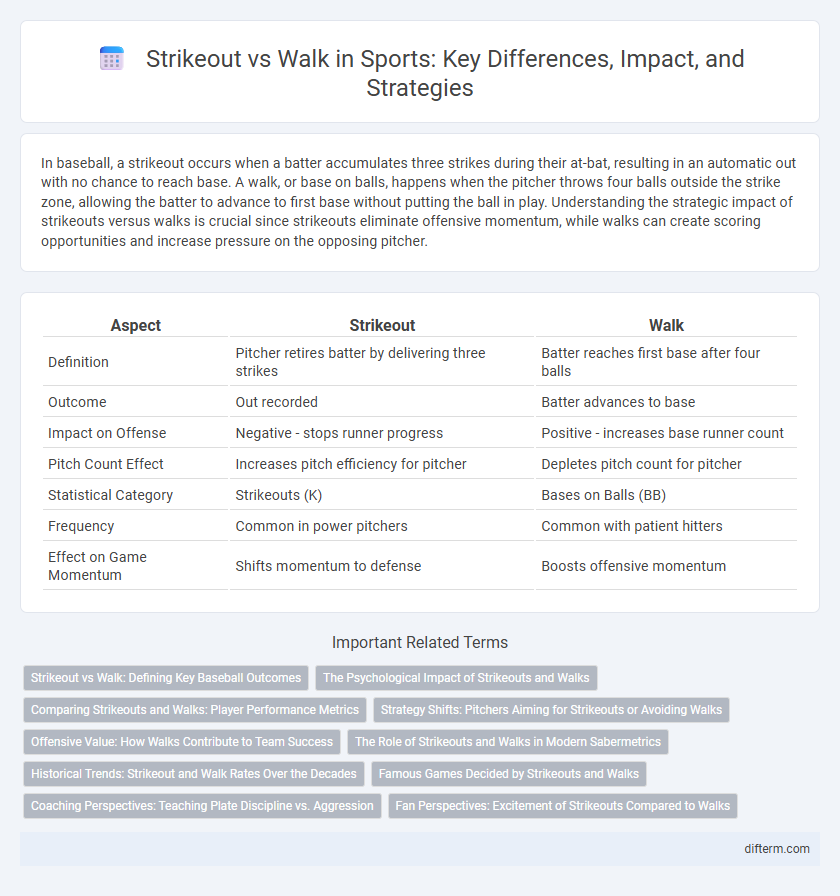In baseball, a strikeout occurs when a batter accumulates three strikes during their at-bat, resulting in an automatic out with no chance to reach base. A walk, or base on balls, happens when the pitcher throws four balls outside the strike zone, allowing the batter to advance to first base without putting the ball in play. Understanding the strategic impact of strikeouts versus walks is crucial since strikeouts eliminate offensive momentum, while walks can create scoring opportunities and increase pressure on the opposing pitcher.
Table of Comparison
| Aspect | Strikeout | Walk |
|---|---|---|
| Definition | Pitcher retires batter by delivering three strikes | Batter reaches first base after four balls |
| Outcome | Out recorded | Batter advances to base |
| Impact on Offense | Negative - stops runner progress | Positive - increases base runner count |
| Pitch Count Effect | Increases pitch efficiency for pitcher | Depletes pitch count for pitcher |
| Statistical Category | Strikeouts (K) | Bases on Balls (BB) |
| Frequency | Common in power pitchers | Common with patient hitters |
| Effect on Game Momentum | Shifts momentum to defense | Boosts offensive momentum |
Strikeout vs Walk: Defining Key Baseball Outcomes
Strikeouts and walks represent crucial outcomes shaping a pitcher's effectiveness and a team's offensive strategy in baseball. A strikeout halts a batter's progress by recording an out without ball contact, reflecting pitcher dominance and control. Walks, meanwhile, advance a batter without a hit, signaling pitcher inconsistency and providing offensive opportunities through free bases.
The Psychological Impact of Strikeouts and Walks
Strikeouts often intensify a batter's frustration and self-doubt, leading to decreased confidence and increased pressure in subsequent at-bats. In contrast, walks can boost a player's morale by reinforcing patience and strategic thinking, fostering resilience and a positive mindset. Both outcomes significantly influence a player's psychological state, affecting overall performance and decision-making on the field.
Comparing Strikeouts and Walks: Player Performance Metrics
Strikeouts and walks are critical performance metrics that reveal a baseball player's plate discipline and pitching dominance. High strikeout rates often indicate a pitcher's ability to overpower hitters, while elevated walk rates can signal control issues but also patience and strategic batting from hitters. Analyzing strikeout-to-walk ratios helps teams evaluate player efficiency and overall contribution to game outcomes.
Strategy Shifts: Pitchers Aiming for Strikeouts or Avoiding Walks
Pitchers often adjust their strategy based on game situations, either aggressively targeting strikeouts to dominate hitters or focusing on control to avoid costly walks. Emphasizing strikeouts can minimize ball-in-play risks but may increase pitch counts, while prioritizing walk avoidance helps maintain pitcher efficiency and limits free baserunners. Advanced metrics like strikeout-to-walk ratio (K/BB) provide key insights into a pitcher's effectiveness in balancing these strategic priorities.
Offensive Value: How Walks Contribute to Team Success
Walks contribute significant offensive value by increasing a team's on-base percentage, providing more scoring opportunities and pressuring opposing pitchers. Unlike strikeouts, which end an offensive opportunity without advancing runners, walks create situations for hitters to drive in runs and sustain innings. Teams with higher walk rates often exhibit better plate discipline, leading to improved run production and overall success.
The Role of Strikeouts and Walks in Modern Sabermetrics
Strikeouts and walks serve as critical metrics in modern sabermetrics, influencing a player's value by highlighting plate discipline and pitching effectiveness. Strikeouts indicate a pitcher's dominance and ability to induce weak contact, while walks reflect a batter's patience and pitch recognition skills. Advanced stats like strikeout-to-walk ratios and on-base percentage integrate these elements to assess overall offensive and defensive contributions more precisely.
Historical Trends: Strikeout and Walk Rates Over the Decades
Strikeout rates in Major League Baseball have steadily increased from the 1960s to the present, rising from an average of roughly 4.5 strikeouts per nine innings to over 8.5 in recent seasons, reflecting a shift toward power pitching and aggressive plate approaches. Conversely, walk rates have fluctuated but generally declined since the 1980s, dropping from around 4.5 walks per nine innings in the 1970s to approximately 3.2 walks per nine innings today, indicating changing hitter patience and strike zone interpretations. These historical trends highlight the evolving dynamics of pitcher-hitter interactions and strategic adjustments across decades of play.
Famous Games Decided by Strikeouts and Walks
Iconic sports moments like the 2020 World Series Game 6, where the strikeout of Jose Altuve sealed the victory for the Los Angeles Dodgers, underline the decisive power of strikeouts. Conversely, the 2016 World Series Game 7 saw pivotal walks, such as the four bases on balls that led to key runs for the Chicago Cubs, breaking their 108-year championship drought. These examples highlight how strikeouts and walks can dramatically influence the outcome of famous baseball games.
Coaching Perspectives: Teaching Plate Discipline vs. Aggression
Effective coaching balances teaching plate discipline and aggression to optimize player performance at the plate. Emphasizing strike zone awareness helps hitters reduce strikeouts by recognizing pitches to swing at, while disciplined patience encourages drawing walks, boosting on-base percentage. Coaches tailor strategies based on player tendencies, promoting calculated aggression against pitchers to maximize offensive value.
Fan Perspectives: Excitement of Strikeouts Compared to Walks
Fans often find strikeouts more exciting due to their dramatic and definitive nature, as they showcase a pitcher's dominance and skill. Walks, while strategically valuable, tend to slow down the pace and lack the immediate thrill that strikeouts generate. The high energy and suspense during a strikeout create memorable moments, enhancing the overall spectator experience.
strikeout vs walk Infographic

 difterm.com
difterm.com